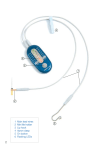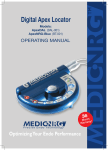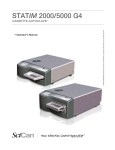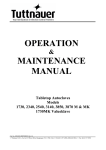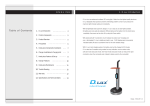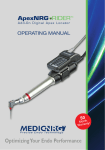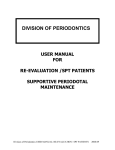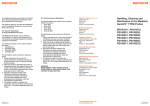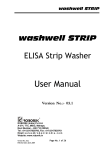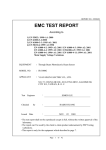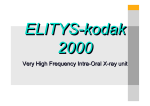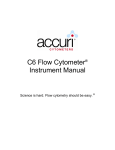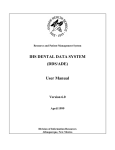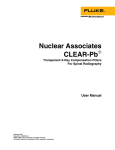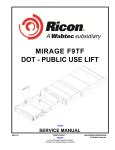Transcript
Apex NRGBLUE TM Digital Apex Locator Measuring The Biological Apex Table of Contents Initial Setup Directions For Use Battery Power Battery Replacement Sterilization PREPARATORY TREATMENT RECOMMENDATIONS Exceptions FREQUENTLY ASKED QUESTIONS Included in box: Part numbers for re-order: Classification Technical Specifications Cautions and Warnings Symbols Register your device on our website today! 4 1 6 5 2 3 1 2 3 4 5 6 Main lead wires Mini file holder Lip hook Apron clasp On Button Flashing LEDs ApexNRG Blue The Digital Apex Locator is designed to meet international safety and performance standards. Personnel operating the instrument must have a thorough understanding of the proper operation of the instrument. These instructions have been prepared to aid medical and technical personnel to understand and operate the instrument. Do not operate the instrument before reading this manual and gaining a clear understanding of the operation of the instrument. If any part of this manual is not clear, please contact your representative for clarification. The Digital Apex Locator calculates the distance from the tip of your endodontic file to the foramen by measuring the signals between two electrodes. The first electrode is the lip hook The second is the mini file holder which makes contact with a file or plugger that has been inserted into the root canal. Technologically Advanced: • There are 8 LEDs to mark the advancement of the file, for precise working length measurement. • The use of DSPallows a much higher level of accuracy and control of the process with measurement results accurate to 0.1 mm and a display resolution of 0.25 mm. • The ApexNRG-BLUE provides precise measurements of the canal under all conditions, including wet, dry and bleeding canals. You can immediately measure another canal, without any special preparation. • There is NO need to calibrate the ApexNRG-BLUE Initial Setup 1. Insert the two main lead wires into the outlets on the right side of the ApexNRG-BLUE (Pic.B). 2. Insert the mini file holder and lip hook into the sockets located at the end of each lead wire (either left or right) (pic.C and Pic.D). 3. Attach the apron clasp to the lead wires by inserting them into the two wire holders on the clasp handles (Pic.E). 4. Insert the ApexNRG-BLUE into a disposable sleeve (Pic.F). 5. Place the ApexNRG-BLUE near the mouth of the patient and attach the clasp to the apron (Pic.G). 6. Place the lip hook located at the end of the cable on the lower lip, preferably on the opposite side of the tooth being treated (Pic.G). Pic.B Pic.C Pic.D Pic.E Pic.F Pic.G 7. Connect the file to the mini file holder (pic.H), then place the file at the entrance to the canal (pic.I). Now you are ready to begin treatment. Pic.H Pic.I Pic.J Directions For Use NOTE: ApexNRG-BLUE should be used only as an adjunct to normal endodontic procedures. While the unit can reduce the number of radiographs necessary, an initial radiograph must be taken to estimate working length. Clinical judgment, including knowledge of root canal anatomy, is paramount when interpreting results. 1. Activate the ApexNRG-BLUE by pressing the “ON” button on the face of the unit or by making contact between the lip hook and the mini file holder (Pic.J). Once activated, the LEDs will flash in sequence as a “self-check”. 2. Following this check, the green “Power” LED will light, indicating the ApexNRG-BLUE is in stand by mode. 3. When the file reaches the “2.0” mm point, the blue LED will stay lit. 4. Work the file in a clockwise and counter-clockwise filing motion towards the apex and back until the “0.5” mm point blue LED turns on and the alarm sounds (slow pitch). NOTE: In order to gain the maximum advantage of this advanced DSP technology, the file must be manipulated in slow movements towards the apical constriction (0.0) in clockwise and counterclockwise motions. This is due to the extremely high accuracy and rapidity of measurement of each minute movement of the file. This is especially important in the critical area between 0.5 to the apical constriction (0.0). Swift movement of the file may cause an unsteady LED display. 5. Before reaching the apical constriction, the “0.25” mm blue LED will light. 6. When the file reaches the apical constriction, the “Apex” green LED will light and the alarm sound changes to a faster pitch. 7. Mark the depth of the canal with the file rubber stop. Measure the length of the file and prepare the rest of the files for the treatment according to this length. If you pass the apical constriction, the “[-]” mm orange LED will begin to flash and the alarm will sound (fastest pitch). At this stage, gently rotate the file back out of the canal until the “Apex” mm green LED lights and the alarm sound slows its pitch. Please refer to our preparatory recommendations and FAQ sections for more information. For your convenience: After the length of the canal has been defined and marked on all of the files, the compact and convenient Sensor Probe can be used to confirm the depth of the entering file during the procedure. The result of the momentary contact with the file will be shown on your apex locator immediately. Please note: Contact should be made increasingly often when approaching the apical constriction in order to prevent perforation. The location of the file will be shown on the apex locator only during direct contact with the sensor. Device Power Off As an energy-conservation feature, the ApexNRG-BLUE will turn off after approximately 3 minutes of non-use. Battery Power The ApexNRG-BLUE is supplied with AA rechargeable batteries and a charger. However, also regular AA batteries may be used with the device. Bluetooth® Wireless Transmission consumes additional battery power; therefore we recommend that one battery is kept charged at all times, in order to allow quick replacement in the event of low battery power. When the ApexNRG-BLUE recognizes low battery power, upon turning on the unit, every other LED will light simultaneously with beeping sounds. This is a warning to change the battery soon (still fully functional). If after an additional period of time the operator has not changed the battery, the unit will turn off automatically upon being turned on and will not allow the operator to use the unit. Replace the battery immediately. There are no other user serviceable items within the unit. If there are any functional problems with the unit, the please contact your local MedicNRG representative for further guidance. Warning! Low battery power affects accuracy. Warning! Charge only rechargeable batteries. Battery Replacement • Remove the battery by sliding out the battery cover on the back of the ApexNRG-BLUE (Pic.K) • Remove the battery from the device (Pic.L) and replace with a fresh battery (type AA). • Be sure to insert the battery with the – sign toward the spring. • Slide the battery cover back into the device until you feel a click (Pic.M) Dispose of depleted battery in accordance to local regulations. Pic.K Pic.L Pic.M Sterilization Warning! Do not place the ApexNRG-BLUE into the Autoclave!! Do not submerge the device or allow liquid to enter the unit enclosure! The main lead wires, mini file holder, lip hook and apron clasp can be sterilized in the autoclave, according to the autoclave manufacturer’s instructions (usually at 121ºC for 20 minutes or at 134ºC for 5 minutes). Attention! The ApexNRG-BLUE is not supplied in a sterile state. All surfaces of the device and its accessories should be disinfected when the unit is initially received and thereafter between procedures, to prevent cross-infection. Thoroughly wipe all surfaces of the unit with a clean cloth moistened in 70% ethyl alcohol solution or any medical device disinfectants. Recommendations for a successful treatment 3 Prior to measuring root canal length with your ApexNRG-BLUE: 2 • Make sure that the pulp chamber 1 is dry before inserting the measuring file. It is recommended to dry the pulp chamber with a cotton pellet or by a slight aspiration of the moisture with an aspiration syringe. Also ensure that all canals are isolated from each other. Excessive fluids in the pulp chamber or canals may form a conductive bridge between canals or with a metallic restoration or crown. Drying the canal with a paper point may help increase accuracy. 1 4 • When the walls of the pulp chamber are damaged 2 , or there are damaged fillings 3 , saliva leakage can occur from the oral cavity, which will prevent drying of the chamber. A moist chamber may cause the immediate formation of a closed electrical circuit, i.e., a short circuit. In this event, the apex locator will issue a warning (flashing red LED and audible alarm) as if it reached the apex (false positive reading). In such cases the missing chamber wall should be temporarily restored, but only with nonconductive materials such as Composite, IRM, GI (glass iononer), etc. After restoration, a dry chamber can be achieved and accurate measurement can be reached. • Most momentary contact with metal or amalgam fillings will be filtered out by the Digital Apex Locator. However, continuous contact will ground the device, so take special care to prevent contact between the file and any existing metalbased restoration of the tooth by amalgam filing or metal crown. In such instances, an adequate insulation of the file from the metallic environment can be achieved by fitting 2-3 rubber stoppers onto the part of the file that may contact the metal of the restoration. • A preliminary extirpation is recommended before beginning measurement. Residual tissue may result in a premature and erroneous reading. • When using a rubber dam, make sure that it is properly sealed around the insertion area. Any aperture between the rubber dam and tooth can be sealed with a temporary restoration. Leading endodontists recommend the use of rubber dams during every root canal treatment. • Ensure the lip hook fully contacts the patient’s moist mucosa. The lip hook should not make contact with any adjacent teeth, which may have metal fillings. • Check all connections. • While some of the accessories are autoclavable, if any accessory seems damaged after a number of autoclave cycles, please replace with a new part. Particularly check the lead wire cables. (see the section on "sterilization" for a full list of the autoclavable items). Recommendations for the measurement process Prepare a wide canal orificium and prepare the first 2/3 in a tapered way to prevent contact with premature constrictions in the canal. • The file should be inserted into the canal in a filing motion (clockwise and counter-clockwise). Rotation of the file in one direction may cause the file to break inside the canal! • Take care to ensure continuous contact between the file and the root canal wall. It is recommended to use the largest possible file that will reach the estimated working length. A loose file that does not make continuous contact with the canal wall will be unable to perform accurate measurements. • Ensure continuous and strong contact between the file and its holder (this may be problematic with the thinner files 6, 8, 10 mm). • In excessively desiccated canals, moistening is recommended to improve conductivity. This can be performed by slight irrigation and/or by slight lubrication of the file. • If the canal is too dry, introduce NaOCl to the apical third of the canal. Exceptions • In a very wide canal, the Digital Apex Locator may be able to read the measurement only at the tip where the canal constricts toward the apical foramen. In such cases only a depth of 0.5 mm and apical foramen, will be identified. Reading may be improved by using a larger file and making definite contact with the canal wall. • The apex locator reading may be unstable in the following tooth pathology situations: decay (caries in the pulp chamber), strong bleeding in the canal, metallic restoration, periapical lesion, open apex 4 , excessively wide canal. • Bone or periodontal ligament loss (indicated by a radiolucency on the film) can cause inaccurate readings. • A worn out battery will reduce the accuracy of the reading. The battery should be replaced as soon as the instrument's warning signal appears, as detailed in the user manual. Take care to follow the instructions for connecting the cables to the instrument as specified in the user manual. In all instances of erroneous readings as described above only a premature reading situation is possible, due to ostensible recognition of the apex. However, the ApexNRG will not show a delayed reading that may endanger the periapical tissues The Apex NRG is a digital electronic device and as such requires a minimum residual battery voltage to drive the circuitry. It therefore requires replacement when this point has been reached even thought there may be sufficient power left for the LEDs to turn on. Troubleshooting Question Solution Unit shows that the file is at the apex when instrument has only just been introduced to the canal. Either pulp chamber floor is not completely dry or the file has contacted a metallic restoration. In either case, the inaccurate readings are due to shorting the circuit. Dry the pulp chamber if it is wet. Reading on unit is not steady. File is in intermittent contact with the canal walls. Either place a curve at the tip of the file or try a larger size file so the tip touches the wall near the apex. No lights show. Battery is flat or has not been replaced correctly (see below) Several LEDs illuminate simultaneously. Warning to replace battery as soon as possible. As a warning of this every other LED will flash several times before going off. Replace battery. The reading on the device does not coincide with the result of the X-ray. The x-ray is a two-dimensional image which cannot accurately find the biological apex. Therefore, the result of the apex locator should be relied upon for determining the correct working length. In addition, bone or periodontal ligament loss (indicated by a radiolucency on the film) can cause inaccurate readings The unit will not switch off. Battery is low. Replace battery. Unit does not work when battery has been replaced. The battery has been inserted incorrectly. The “-“ sign should be facing the spring. The correct battery insertion position is etched on the device. See battery replacement instructions for more information. Included in box • • • • • • • • • • • • • ApexNRG-BLUE (1 unit) Lead Wires (4 units) – autoclavable File Clip Cable (1 unit) – autoclavable Lip Hook (2 units) – autoclavable Apron Clasp (2 units) – autoclavable Mini File Holder (3 units) – autoclavable Mini Sensor Probe (1 unit) – autoclavable Disposable Sleeves Packet (20 sleeves) Rechargeable batteries (type AA) Battery Charger Bluetooth Dongle USB Extension Cable Software Installation CD Accessories (Not included) • Long Sensor Probe – DE002-1-10 • Extension Cables - DE002-1-7 Part numbers for re-order: • • • • • • • • • ApexNRG-BLUE - BT-001 Lead Wires – DE003-1-1 File Clip Cable – DE003-1-2 Lip Hook – DE002-1-3 Apron Clasp – XFR-001-3 Mini File Holder – XFR-001-4 Mini Sensor Probe – DE002-1-9 Long Sensor Probe – DE002-1-10 Disposable Sleeves Packet – DE002-1-4 Classification • • • • • • Type BF applied part. IEC 601-1 Compliant Medical Equipment Internally powered equipment Continuous operation Device is not supplied in a sterile state. Ordinary protection against ingress of water is required. Technical Specifications • • • • • • Power Supply: Single AA battery. Power input: 1.0 – 1.5 V Maximum current: 30mA Operating temperature: +10ºC - +40ºC Humidity: 10% - 90% without condensation. Transport/Storage: -15 ºC - +50 ºC Cautions and Warnings DANGER: Not for use in the presence of a flammable anesthetic mixture with air or with oxygen or nitrous oxide. Non-AP and non-APG equipment. WARNING: The apex Locator should NOT be used on a patient with a pacemaker. WARNING: Do not plug any connectors or pins on the file clip or probes into any external power source, as it may cause a severe safety hazard to the patient. WARNING: Only use the specified battery. WARNING: Use of other accessories which are not authorized for use in connection with this device may cause malfunction and compromise patient safety. CAUTION: This device has been investigated with regard to safety from electrical shock and fire hazard as well as electromagnetic compatibility (EMC). The device has not been investigated for other physiological effects. CAUTION: For use by qualified and trained personnel only. CAUTION: This device to be used in conjunction with other diagnostic procedures and not relied on exclusively. CAUTION: Do not autoclave the unit. CAUTION: This device has been tested and found to comply with EMC limits for the Medical Device Directive 93/42/EEC (EN 55011 Class B and EN 60601-1-2). these limits are designed to provide reasonable protection against harmful interference in a typical medical installation. However, there is not guarantee that interference will occur in a particular installation. The device generates radio frequency and, if not installed and used in accordance with these instructions, may cause harmful interference to other devices in the vicinity. If this device does cause harmful interference with other devices, which can be determined by turning the device off and on, the user is encouraged to try to correct the interference by one or more of the following measures: • Reorient or relocate the receiving device • Increase the separation between devices • Consult the manufacturer for help CAUTION: To reduce the risk of electrical shock do not remove cover. Refer servicing to qualifi ed service personnel. CAUTION: U.S. Federal Law restricts this device to sale by or on the order of a health care professional. Symbols Corresponds to MDD 93/42 EEC 0034 UL mark with “C/US” indicator for certified products, including EN 60601-1 and EN 60601-1-2 Attention! Consult manual before use. Type BF Patient Applied Part Packaging / Handling Symbols Fragile, handle with care Temperature limits for storage and transportation Keep dry Disposal in municipal waste may be restricted by state or local ordinance. Dispose of in accordance with state and local regulations, or contact manufacturer for guidance. Register your device on our website today! Software upgrades will be sent to registered users only. Register now at: www.medicnrg.com on the Contact Us form or send an email to [email protected]
